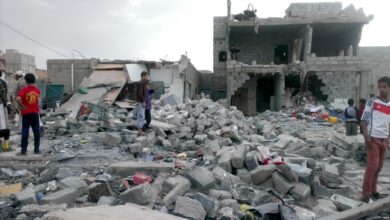Reverse Trend: Increased Houthi Attacks and Decreased U.S. Strikes

Despite the rise in Houthi attacks against commercial ships since early August, U.S. forces have shown a relative decrease in preemptive strikes and interception operations.
-
They Were in the Brotherhood’s Stronghold: Arrest of a Houthi Cell on Its Way to Sanaa
-
The Houthi Militias Form a New Government… Will the Muslim Brotherhood Be Included?
Early Friday, U.S. Central Command announced the destruction of an “Iranian-backed Houthi missile system and a drone in a rebel-controlled area” the previous day, strikes that the militias kept silent about.
According to data from U.S. forces, 31 Houthi targets or pieces of equipment were destroyed since the beginning of August, marking a decrease of about 50% compared to the previous month, which saw over 60 targets destroyed through interceptions or preemptive strikes to protect ships.
-
Yemeni Analyst Reveals: Houthi Militias Habitually Target Organizations and Charities
-
The Brotherhood Strengthens Its Relationship with the Houthis… What’s New?
Reduced Response
This month, the U.S. response has not matched the heightened threat posed by the Houthis, especially since their official resumption on August 4 of attacks on cargo ships, after about 14 days of halt following Israel’s retaliatory strikes on the port of Hodeidah and its surroundings on July 20.
The Houthis have launched anti-ship missiles and drones almost daily, some hitting tankers, though most have missed their targets. They have also deployed armed boats for harassment and engagement.
-
The Houthis and Somali al- Shabaab: “The Devil’s Alliance” Reaches the Horn of Africa
-
After Israel’s Attack on Hodeidah… Houthi Threats to Continue Targeting International Ships
Over the past 26 days, the Houthi militias claimed responsibility for targeting nearly 8 commercial ships in the Gulf of Aden and the Red Sea, the most notable being the missile attack on the *Sonion* oil tanker on August 21.
Following that, the Houthis launched an armed attack on the tanker after a French frigate evacuated its crew, planting explosives and remotely detonating them to film a propaganda video aimed at stirring panic in commercial shipping, hoping to push more companies to avoid one of the world’s most important maritime corridors.
-
Yemeni Analyst: Houthi Operations in the Red Sea Have a Significant Economic Cost
-
Worrying measures taken by the Houthi terrorist militia before the new school year: What are they?
Drones Lead the Way
Statistics for August and July show that drones were the Houthis’ most-used weapon to threaten navigation, with 42 drones out of 91 Houthi targets or equipment destroyed in their controlled areas or intercepted over the sea.
U.S. interception operations targeting drones and missiles aimed at ships were predominantly in the Red Sea compared to the Gulf of Aden, indicating the Houthis have focused their recent wave of attacks on the Red Sea to combine the use of multiple weapons.
-
In a surprising decision, the Houthis threaten to target Saudi Arabia
-
Houthis and Muslim Brotherhood fail Muscat negotiations… Latest developments
As for strikes on active Houthi military sites to prevent the launching of missiles or drones, they mainly targeted Hodeidah, Sanaa, Hajja, and Taiz. The Houthis admitted to having been hit by 17 airstrikes in these provinces, including 13 in Hodeidah, but remained silent about others.
In August, U.S. strikes destroyed about 11 drones, at least 8 missiles, including anti-ship and cruise missiles, 4 armed boats, two missile launch platforms, two air defense systems, a radar, and three ground control stations, according to statistics.
-
Source reveals rifts within Houthis due to deteriorating security and economic conditions… Details
-
US “Punishes” Houthis: Drones and Control Station Destroyed
In comparison, in July, U.S. strikes focused on Hodeidah, Hajja, Taiz, and Saada, destroying 31 drones, 18 armed boats, 4 radars, 3 missile launch platforms, and 2 surface-to-air missiles (SAM), with U.S. partner forces intercepting and destroying 2 more drones.
The U.S. forces recently modified their defense plan to counter Houthi maritime attacks by implementing aerial and electronic surveillance systems and using drones equipped with air-to-ground missiles capable of staying airborne for hours to monitor and strike launch bases, according to media sources.
-
Houthi and Al-Qaeda Shift Relationship from Covert Cooperation to Field Coordination
-
Brotherhood-Houthi agreement to halt the development of Aden Port… Why?
Since last November, the Houthis have been attacking maritime traffic in the Red Sea, claiming it as an act of solidarity with Palestinians in the Gaza war. However, this has impacted a route that handles about 12% of global trade.












